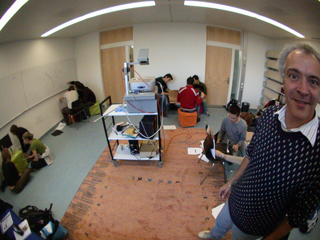| Tobi Delbruck | |||||||||||
| Home | Wiki | Motivation | History | People | Projects | Publications | Resources | Fun | Contact | ||
| Downloads | Availability | Significance | Users | Links |
The Phyiologist's Friend Chip electronically emulates cells in the visual system and responds realistically to visual stimuli.
New: complete design available
If you are a physiologist working on the properties of the early visual system, you could use this chip as a simple substitute animal. You could use it to train students to run your rig. Or you could use it as a set of realistic and known receptive fields with spiking or analog responses for developing new spike-triggered averaging techniques. Or when debugging a new setup, you can use it simply to make sure everything runs as expected. The idea is that experimenters can test nearly the complete loop -- which generally involves stimulus generation, recording, and analysis, without using actual animals. Bugs in the large portions of the setup can be found before any animals are used..
If you teach about how the brain works, the chip is a captivating way to involve the students in demonstrations of a number of basic properties of the visual system: adaptation, complementary (ON/OFF) coding, spikes, complementary push-pull input to cortical cells. Using an overhead projector, you can conduct experiments on this model visual system.
The chip outputs an ON and OFF retinal ganglion cell and two orientation-tuned cortical simple cells. Analog membrane potentials are also output and can be used to check spike discrimininators.
A software simulation that models more types of cells is the Physio Friend program.

The Physiologist's Friend Chip
| A user guide shows how to use the chip for demonstrations and in the lab | Download PDF | |
| Slides that we have used in conjunction with the chip | Download PDF | Download PowerPoint |
| T. Delbruck, S.C. Liu. (2004). A silicon visual system as a model animal. Vision Research, vol. 44, issue 17, pp. 2083-2089 (preprint; copyright restrictions prevent putting journal version here.) | PDF of vision research article | |
| NEW Physiologist's Friend Chip design | See this page |
As of August 2009 we are in the process of building up the final lot of approximately 15 of the Physiologist Friend Chip systems based on the friend23 chip; the process in which this chip was designed has been discontinued and no more silicon can be produced. Please contact Tobi Delbruck (tobi@ini.phys.ethz.ch) to inquire about availability. The most recent shipment of 3 systems went to the NatLab at the Freie Uni Berlin for hands-on use in teaching children and undergraduates about the nervous system:
Why do I think this chip is a significant advance in neuromorphic engineering? It is true that it is a very simple chip that uses circuits and architectures that for the most part have been around for a long time. So why do I think it is important?
The Physiologist's Friend Chip is used by about 15 labs around the world.
| David van Essen | Washington Univ. |
| Gilles Laurant | Caltech |
| Kevan Martin | Inst. of Neuroinformatics, ETH/Univ. Zurich |
| Daniel Kiper | Inst. of Neuroinformatics, ETH/Univ. Zurich |
| Matteo Carrandini | Smith Kettelwell |
| Rich van Wezel | Univ Utrecht |
| Florentin Worgotter | Univ. Stirling |
| Matthias Henning | Univ. Stirling |
| Natalie Hempel de Ibarra | Freie Universitaet, Berlin |
| Rudolf Menzel | Freie Universitaet, Berlin |
| Lyle Borg-Graham | Neurophysique et Physiologie du Systeme Moteur CNRS |
| Ulf Eysel | Ruhr Univ. Bochum |
| Pam Reinigal | UC San Diego |
| Wyeth Bair | Univ. of Oxford |
| Bernd Porr | Univ. of Glasgow |
| Henry Markram | EPFL, Lausanne, Switzerland |
| Lauriston Kellaway | University of Cape Town |
| Sebastian Seung | MIT |
| Prakash Kara | Univ. of S. Carolina |
| Petra Skiebe-Corrette | Freie Universitaet, Berlin |
| Sorinel Oprisan | College of Charleston, South Carolina |
August 2009: New boards are being built! This will be the last lot because MOSIS has shut down the 1.6u AMI process in which this design has been fabricated.
Nov. 2006 & Oct 2007: Daniel Kiper, Stephan Roth, and Tobi Delbruck used 4 Physio Friend chips in a biology block course first for understanding receptive fields and later for quantitative measurements of photoreceptor response properties.



Students learn to plot receptive fields of retinal and simple cells. Dan Kiper is in the right photo.
Matthias Hennig and Bernd Porr at the University of Stirling have used the chip for demonstrations and instruction. They have developed a linux-based USB data acquisition device.
Return to PhysioFriend Home page. Go to PhysioFriend Program.
| Home | Motivation | History | People | Projects | Publications | Resources | Fun | Contact |